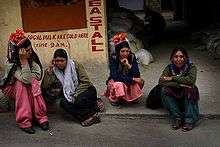Brokpa
 Brokpa women dressed in folk costume in Ladakh | |
| Total population | |
|---|---|
| 48,439 (2011 census)[1] | |
| Regions with significant populations | |
| Garkon, Dha-Hanu,Sharchay-Batalik in Ladakh and Gilgit-Baltistan | |
| Languages | |
| Brokskat | |
| Religion | |
| Islam[2] with a small Buddhist minority. | |
| Related ethnic groups | |
| Dard people |
The Brokpa are a small community of Dard people residing in Jammu and Kashmir region, about 163 km (101 mi) northwest of Leh and 62 km (39 mi) north of Kargil in Ladakh.[3]
They are mainly found in Dha, Beama, Garkon, Darchiks, Batalik, Sharchay and Chulichan. Part of the community are also located in the Deosai plateau just across the LOC in the villages Ganoaks, Morol, Dananusar, and Chechethang in Baltistan. Like the people of Gilgit, they speak a variant of Shina language, Brokskat, unintelligible with other Shina dialects. They are said to have originally come from Chilas and settled in the area generations ago. They are predominantly Vajrayana Buddhists with a blend of folk animism and minority follow Shia Islam.
Minaro is an alternate ethnic name. 'Brogpa' is the name given by the Ladakhi to the people.[4] It derives from Drukpa, which comes from the Tibetan word 'Drugu' (for an ethnic Turk.) This is an accurate demonym, considering that the Turkic Trakhàn dynasty were once ruling the Karakoram region. Or it may just mean འབྲོག་པ། (pronounced Brokpa in Ladakh) a word for nomads.
Diet
The traditional Brogpa diet is based on locally grown foods such as barley and hardy wheat prepared most often as tsampa/sattu (roasted flour). It takes in different ways. Other important foods include potatoes, radishes, turnips, and Gur-Gur Cha, a brewed tea made of black tea, butter and salt.
Dairy and poultry sources are not eaten because of religious taboos. Brogpa eat three meals a day: Choalu Unis (breakfast), Beali (lunch) and Rata Unis (dinner). Brogpa vary with respect to the amount of meat (mainly mutton) that they eat. A household's economic position decides the consumption of meat. It is only during festivals and rituals that all have greater access to mutton.[5]
Economy and employment
The Brogpa economy has shifted from agropastoralism to wage labor, and the division of labor that relied on stratifications of age and gender is now obsolete. The Brogpa transition to private property, monogamy, nuclear families, formal education, wage labor, and their incorporation into a highly militarized economy of soldiering and portering illuminates the complex workings of modernity in Ladakh.[6]
See also
References
- ↑ "ST-14 Scheduled Tribe Population By Religious Community". Census of India. Ministry of Home Affairs, India. Retrieved 15 October 2017.
- ↑ http://blog.cpsindia.org/2016/12/religion-data-of-census-2011-xxxiii-jk.html?m=1
- ↑ From Nomadic Tribesmen to Nazi Icons: Who Were the Aryans?, heritage-key.com Archived 7 August 2010 at the Wayback Machine.
- ↑ Ethnologue. Brokskat - A language of India. Minaro
- ↑ Bhasin, Veena: Social Change, Religion and Medicine among Brokpas of Ladakh, Ethno-Med., 2(2): 77-102 (2008)
- ↑ Bhan, Mona. "Becoming Brogpa". Counterinsurgency, Democracy and the Politics of Identity in India. Routledge South Asia Series.